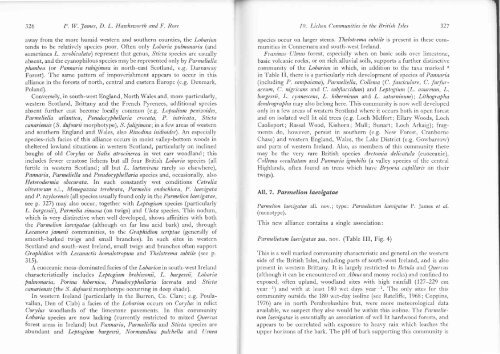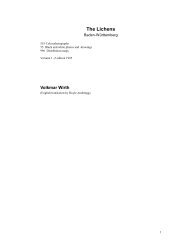Lichen communities in the British Isles: A preliminary conspectus
Lichen communities in the British Isles: A preliminary conspectus
Lichen communities in the British Isles: A preliminary conspectus
Create successful ePaper yourself
Turn your PDF publications into a flip-book with our unique Google optimized e-Paper software.
326 P. W. James, D. L. Hawksworth and F. Rose<br />
away from <strong>the</strong> more humid western and sou<strong>the</strong>rn counties, <strong>the</strong> Lobarion<br />
tends to be relatively species poor. Often only Lobaria pulmonaria (and<br />
sometimes L. scrobiculafa) represent that genus, Sticta species are usually<br />
absent, and <strong>the</strong> cyanophilous species may be represented only by Parmeliella<br />
plumbea (or Pannaria rubig<strong>in</strong>osa <strong>in</strong> north-east Scotland, e.g. Darnarvay<br />
Forest). The same pattern of impoverishment appears to occur <strong>in</strong> this<br />
alliance <strong>in</strong> <strong>the</strong> forests of north, central and eastern Europe (e.g. Denmark,<br />
Poland).<br />
Conversely, <strong>in</strong> south-west England, North Wales and, more particularly,<br />
western Scotland, Brittany and <strong>the</strong> French Pyrenees, additional species<br />
absent fur<strong>the</strong>r east become locally common (e.g. Lopadium pezizoides,<br />
Parmeliella atlantica, Pseudocyphellaria crocata, P. <strong>in</strong>tricata, Sticta<br />
canar;ensis (5. dufourii morphotype\, S. fulig<strong>in</strong>osa; <strong>in</strong> a few areas of western<br />
and sou<strong>the</strong>rn England and Wales, also R<strong>in</strong>od<strong>in</strong>a isidioides). An especially<br />
species-rich facies of this alliance occurs <strong>in</strong> moist valley-bottom woods <strong>in</strong><br />
sheltered lowland situations <strong>in</strong> western Scotland, particularly on <strong>in</strong>cl<strong>in</strong>ed<br />
boughs of old Corylus or Salix atroc<strong>in</strong>erea <strong>in</strong> wet carr woodland; this<br />
<strong>in</strong>cludes fewer crustose lichens but all four <strong>British</strong> Lobaria species (all<br />
fertile <strong>in</strong> western Scotland; all but L. laeteoirens rarely so elsewhere),<br />
Pannaria, Parmeliella and Pseudocyphellaria species and, occasionally, also<br />
Heterodermia obscurata. In such constantly wet conditions Cetreliq<br />
oliztetorum s.1., Menegazzia terebrata, Parmelia endochlora, P. laez,tigata<br />
and P. taylorensis (all species usually found only <strong>in</strong> <strong>the</strong> Parmelion laeztigatae,<br />
see p. 327) may also occur, toge<strong>the</strong>r u,ith Leptogium species (particularly<br />
L. burgessii), Parmelia s<strong>in</strong>uosa (on twigs) and Ulota species. This nodum,<br />
which is very dist<strong>in</strong>ctive when well developed, shows aff<strong>in</strong>ities with both<br />
<strong>the</strong> Parmelion laevigatae (although on far less acid bark) and, through<br />
Lecanora jamesii <strong>communities</strong>, to <strong>the</strong> Graphidion scriptae (generally of<br />
smooth-barked twigs and small branches). In such sites <strong>in</strong> western<br />
Scotland and south-west Ireland, small twigs and branches often support<br />
Graphidion with Lecanactis homalotropum and Thelotrema subtile (see p.<br />
31s).<br />
A euoceanic moss-dom<strong>in</strong>ated facies of <strong>the</strong> Lobareoz <strong>in</strong> south-west Ireland<br />
characteristically <strong>in</strong>cludes Leptogium brebissonii, L. burgessii, Lobaria<br />
pulmonaria, Por<strong>in</strong>a hibernica, Pseudocyphellaria lacerata and Sticta<br />
canariensis (<strong>the</strong> S. dufourii morphotype occurr<strong>in</strong>g <strong>in</strong> deep shade).<br />
In western Ireland (particularly <strong>in</strong> <strong>the</strong> Burren, Co. Clare; e.g. Poulavallan,<br />
Den of Clab) a facies of <strong>the</strong> Lobarion occurs on Corylus <strong>in</strong> relict<br />
Corylus woodlands of <strong>the</strong> limestone pavements. In this community<br />
Lobaria species are now lack<strong>in</strong>g (currently restricted to mixed Quercus<br />
forest areas <strong>in</strong> Ireland) but Pannaria, Parmeliella and Sticta species are<br />
abundant and Leptogium burgessii, Normand<strong>in</strong>a pulchella. and (Jsnea<br />
10. <strong>Lichen</strong> Communitt)es <strong>in</strong> <strong>the</strong> Ilritish <strong>Isles</strong> 327<br />
specics occur on larger stems. Thelotrema subtile is present <strong>in</strong> <strong>the</strong>se <strong>communities</strong><br />
<strong>in</strong> Connemara and south-west Ireland.<br />
Frax<strong>in</strong>us (Jlmus forest, especially when on basic soils over limestone,<br />
basic volcanic rocks, or on rich alluvial soils, supports a fur<strong>the</strong>r dist<strong>in</strong>ctive<br />
community of <strong>the</strong> Lobarion <strong>in</strong> which, <strong>in</strong> addition to <strong>the</strong> taxa marked "<br />
<strong>in</strong> Table II, <strong>the</strong>re is a particularly rich development of species of Pannaria<br />
(<strong>in</strong>clud<strong>in</strong>g P. sampaiana), Parmeliella, Collema (C. fasciculare, C. furfuraceum,<br />
C. nigricans and C. subflaccidum) and Leptogium (L. azureum, L.<br />
burgessii, L. cyanescens, L. hibernicum and L. saturn<strong>in</strong>um); Lithographa<br />
dendrographa may also belong here. This commr,rnity is now well developed<br />
only <strong>in</strong> a few areas of western Scotland where it occurs both <strong>in</strong> open forest<br />
and on isolated well lit old trees (e.g. Loch Melfort; Ellary Woods, Loch<br />
Caolisport; Rassal Wood, Kishorn; Mull; Sunart; Loch Arkaig); fragments<br />
do, however, persist <strong>in</strong> sou<strong>the</strong>rn (e.g. New Forest, Cranborne<br />
Chase) and r,r,estern England, Wales, <strong>the</strong> Lake District (e.g. Gowbarrorv)<br />
and parts of western Ireland. Also, as members of this community thcre<br />
may be <strong>the</strong> very rare <strong>British</strong> species Arctomia delicatula (euoceanic),<br />
Collemtt occultatum and Pannaria ignohilis (a valley species of <strong>the</strong> central<br />
Flighlands, often found on trees which have Bryoria capil.laris on <strong>the</strong>ir<br />
twigs).<br />
All. 7. Parrnelion laeoigatae<br />
Parmelian laedgatae all, nov.; type: Parmelietum laeoigatae P, James et al.<br />
(monotype).<br />
This new alliance conta<strong>in</strong>s a s<strong>in</strong>gle association:<br />
Parmehletum laeztigatae ass. nov. (Table III, Fig. 4)<br />
This is a well marked community characteristic and general on <strong>the</strong> westcrn<br />
side of <strong>the</strong> <strong>British</strong> <strong>Isles</strong>, <strong>in</strong>clud<strong>in</strong>g parts of south-west Ireland, and is also<br />
present <strong>in</strong> western Brittany. It is largely restricted to Betula ard Quercus<br />
(although it can be encountered on Alnus and mossy rocks) ancl conf<strong>in</strong>ecl to<br />
exposed, often upland, woodland sites q'ith high ra<strong>in</strong>fall (127-229 cm<br />
year 1) and with at least 180 wet days year-l. The only sites for this<br />
community outside <strong>the</strong> 180 wet-day isol<strong>in</strong>e (see Ratcliffe, 1968; Copp<strong>in</strong>s,<br />
7976) are <strong>in</strong> north Pembrokeshire but, were more meteorological clzrta<br />
available, we suspect <strong>the</strong>y also would be with<strong>in</strong> this isol<strong>in</strong>e. 'l'he Parmelietum<br />
laeoigatae is esscntially an association of well lit hardwoocl forests, and<br />
appears to be correlated with exposure to heavy ra<strong>in</strong> which leaches thc<br />
upper horizons of <strong>the</strong> bark. The pH of bark support<strong>in</strong>g this community is





